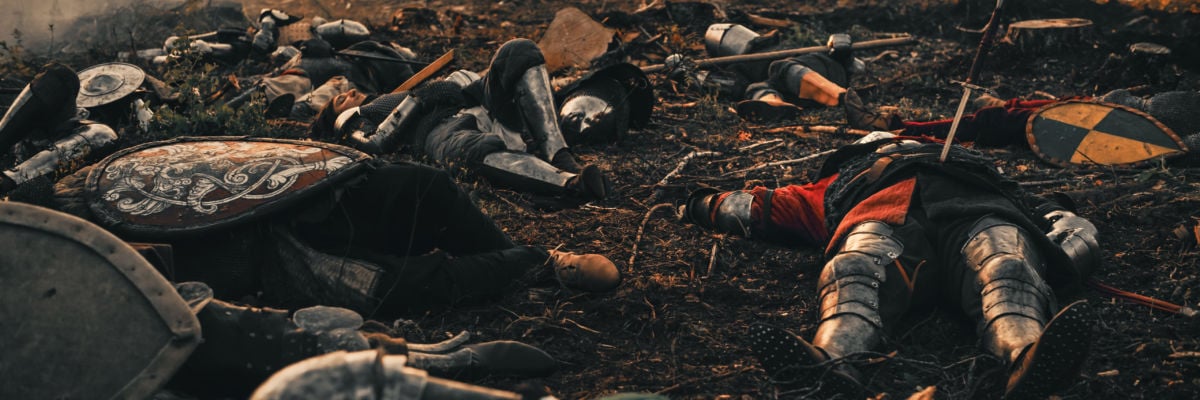
Catholic historian Hilaire Belloc (1870-1953) criticized his contemporaries for “reading backwards into history,” by which he meant the “present continually judging the past from a position of supposed superiority.” Belloc might be surprised by the current trend among some Catholics: today, it is fashionable to “read forwards into history,” meaning the present judging the past with a yearning for the “good old days.”
It is not uncommon to find Catholic commentators highlighting certain centuries or time periods in Church history when the Faith was lived (seemingly) more authentically—when Catholics believed and practiced faithfully, and the hierarchy was replete with holy and orthodox prelates. Frequently, this erroneous view of Church history is used to bemoan the current state of the papacy, the liturgy, sacramental devotion, and theological writing.
There are certainly areas and topics in the Church today that warrant concern and legitimate criticism, where a careful and considerate review of Church history can help us, provided we proceed with great prudence. But the “good old days” mentality is the opposite of all that: specious at best and disingenuous at worst. This mentality fails to acknowledge that every time period has unique political and ecclesial circumstances which cannot be easily replicated.
Whether external or internal, the Church has suffered from crises throughout its existence. This is partly explained by the fact that the Church Militant comprises fallen yet redeemed members endowed with free will, who, even in the highest office, may choose vice over virtue. Church history is awash with clerical and lay saints and sinners, heroes and villains.
It is a necessity to learn from history, but it is perilous to use history to justify criticism of modern issues. Hoping for the Church to “return” to the golden age of this or that century is pollyannish thinking that does a disservice to the necessary efforts of evangelization and catechesis in the modern world. It yields a closed mindset that produces an isolated, frightened, and angry community that neglects the demands of charity and the missionary imperative of the gospel.
Recognizing the differences in human experience in distinctive centuries is vital to a correct interpretation of historical events. Authentic historical interpretation dictates that the historian seek to understand the time period in which the persons studied lived.
Consider the Crusades as one example. A historian who has little cognition of the Catholic faith will be hard pressed to understand the religious motivations of those in the medieval era who left home and family for the arduous and dangerous journey to the Holy Land. A Catholic historian, on the other hand, will understand how the historical record illustrates that many people, combatants and civilians, participated in the crusading movement out of a deep piety rooted in love: for Christ and the Church, their persecuted neighbors in the Holy Land, and concern for their own salvation. Indeed, the unique granting of the papal indulgence prompted large numbers of people to participate in the First Crusade at the end of the eleventh century. These motivations are rooted in basic tenets of the Church, which occupied an integral part of medieval society—and so even a non-Catholic historian must be familiar with those tenets if he hopes to understand his subject.
The same is true for modern-day Catholics who opine on the current state of the Faith. The sentiment that things in the Church “were better before” fails to recognize that the Faith is not static, but lived. How Catholics live the constant teaching of the Church is very much influenced by the times in which they exist. Sacred Tradition is one (unchanging) thing; Catholic tradition is another. Walter Cardinal Brandmüller, the former president of the Pontifical Commission for Historical Sciences, highlighted this point in his 2007 book Light and Shadows: “Whereas changes in the binding dogmas of the faith, in the essential elements of the sacraments and in the core features of the hierarchical-sacramental ministries are unthinkable and have never occurred, changing with the times in other departments of the Church’s life over the course of her history is not only possible, but also necessary if the Church is to accomplish her mission faithfully under the altered circumstances and conditions of the day.”
Church history reveals that debates were waged in previous centuries over the dating of Easter, the proper posture for prayer, the papacy’s authority over secular rulers, how to choose bishops and popes, and the role of the laity. Moreover, it should not be surprising that many of the disciplines and traditions modern-day Catholics recognize and celebrate exist only after centuries of evolution.
One example that many Catholic critics of our times pause might take for granted is frequent reception of the Eucharist. Medieval Catholics, in a time period regarded as the “glory of Christendom,” received the Eucharist perhaps twice a year at most. This led to the institution of the “Easter Duty,” a mandatory annual reception of the Eucharist, imposed by the Fourth Lateran Council in 1215. The practice of receiving daily Communion became widespread only during the Catholic Reformation of the sixteenth century, through the efforts of the newly formed Society of Jesus (Jesuits)—and it wasn’t until the early twentieth century that it became regularized for younger children!
Another example is the evolution of the pastoral application of the sacrament of confession. In the early centuries of the Church, questions surrounded penitential practices and whether sins committed after baptism could be forgiven. One early practice, known as the exomologesis, consisted of a public penitential act, preceded by a declaration of sin to the bishop, who determined the penance and the length of time required to perform it. The penitent wore simple clothes, could not receive the Eucharist, and had to beg fellow Christians before Mass for prayers. The practice could be utilized only once (usually), and the process was not available for certain sins, like apostasy, murder, and fornication. When Pope Callistus I (r. 217-222) allowed those who committed sexual sins to participate in the exomologesis—a decision rooted in mercy—it caused a decades-long schism and the election of the first antipope (St. Hippolytus) in Church history.
Eventually, the exomologesis of the early Church gave way to different methods of celebrating the sacrament. A shift occurred from public penitential practices to private and from proclamation of sin in the presence of the bishop to private auricular confession to a priest. The confessional, a staple of the modern practice of confession, was not introduced until the sixteenth century.
How can the modern-day Catholic avoid falling into the “good old days” trap of historical interpretation? Here are four strategies/suggestions:
- Study Church (and secular) history: Read, read, and read books from a multitude of authors to gain insight and different perspectives of historical events. Those who are concerned about knowing which historian to trust can concentrate on identifiable Catholic writers first and then, with a firm foundation in Catholic history, engage other authors.
- Remember the historical context: Understanding historical events from the perspective of those who lived them is crucial. The political, military, economic, and religious context of the past must remain prominent in any attempt to learn from history and apply those lessons to modern circumstances and situations.
- Avoid static caricatures: History involves the complex story of men and women of the past and their choices and actions. Avoid the temptation to view certain periods of the Catholic past as “the good old days,” and recognize that every age of Church history involves virtue, vice, conflict, and crisis. A desire to return to the supposed “glorious” past—almost certainly not as glorious as you think!—is foolhardy.
- Learn from history; do not use history: Studying the past provides meaning to the present so that the present can help determine the future. Using history to further an agenda or to merely criticize is a misuse of history and a disservice to the men and women of the past. Learning from our brothers and sisters in the Faith provides an opportunity to grow in our faith in Christ’s Church and maintain an even keel in the midst of trying times. Moreover, studying the actions of past Catholics can serve as a model of behavior for appropriate responses to modern-day problems as well as provide a cautionary tale for inappropriate reactions.
Instead of wishing for the “good old days,” Catholics today are better served by a holistic understanding and interpretation of Catholic history so that the Church’s mission of spreading the gospel can be more effective in a world that is in desperate need of Christ.



